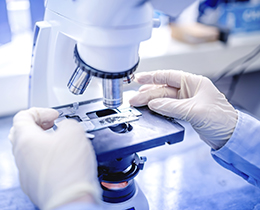Forensics
 ATF laboratories are staffed with highly trained chemists, forensic biologists, engineers, fingerprint specialists, firearm and toolmark examiners, document examiners and administrative personnel. Many of these professionals have held leadership positions in numerous professional scientific organizations and are among the most highly qualified specialists in their fields.
ATF laboratories are staffed with highly trained chemists, forensic biologists, engineers, fingerprint specialists, firearm and toolmark examiners, document examiners and administrative personnel. Many of these professionals have held leadership positions in numerous professional scientific organizations and are among the most highly qualified specialists in their fields.Publications
The below documents are management system documents utilized by ATF Laboratories. They are provided for informational purposes only. Sensitive or copyrighted information has been redacted. The documents are used in ATF Laboratories and not published with the intent of setting a policy or analysis standard for other laboratories. The inclusion of equipment/software manufacturer names does not imply endorsement by ATF Laboratories.
The documents were current as of February 28, 2018. ATF management system documents are reviewed annually and revised as needed. For specific requests, submit a Freedom of Information Act (FOIA) request. Instructions on how to file a FOIA request are found at: www.atf.gov/resource-center/freedom-information-act-foia.
| Name | Description | Type |
|---|---|---|
|
|
NRA Weights (FSL-SF)
| Firearm and Toolmark |
|
|
Ninhydrin, or tri-keto-hydrindene hydrate, is an extremely sensitive indicator of alpha-amino acids, proteins, peptides and polypeptides.
| Latent Prints |
|
|
The purpose of this document is to define terms used throughout ATF quality documents. It is intended to ensure clarity and consistency of terminology.
| Questioned Documents |
|
|
The purpose of this document is to define terms used throughout ATF quality documents. It is intended to ensure clarity and consistency of terminology.
| Quality Manuals |
|
|
This procedure defines authorities and provides Laboratory Services with a mechanism to investigate the cause of nonconformities in the laboratory and to implement, document, and monitor corrective actions.
| Quality Manuals |
|
|
This procedure provides a mechanism to demonstrate Laboratory Services’ efforts at continual improvement. It provides the structure for implementing, documenting and monitoring proactive preventive actions.
| Quality Manuals |
|
|
The process of self-evaluation is a valuable management tool. The assessment process and the system review that follows is a means to promote and encourage the quality and efficiency of operations.
| Quality Manuals |
|
|
This procedure defines authorities and provides Laboratory Services with a framework for conducting a review of the management system.
| Quality Manuals |
|
|
This procedure describes how documents related to the objectives of the management system, including those from external sources, are prepared or received, authorized, issued, controlled and kept. This quality procedure also defines how changes are controlled and how obsolete documents are removed from use, archived and/or destroyed in compliance with the requirements of the Quality Manual.
| Quality Manuals |
|
|
This procedure describes how work is identified, reviewed, and accepted by ATF Laboratories. The procedure also includes the evaluation process that takes place to ensure that Laboratory Services has the required resources to undertake the requested services in accordance with a schedule that meets the needs of the customer(s).
| Quality Manuals |
|
|
To ensure that the subcontracting of test and calibration services is conducted by qualified individuals in a consistent manner using competent subcontractors.
| Quality Manuals |
|
|
This procedure establishes a standard system for ensuring the quality of critical, equipment, services, consumables, and supplies used in laboratory analysis.
| Quality Manuals |
|
|
This policy is a general statement of ATF Laboratory Services overall commitment to meeting the customer’s requests while at the same time delivering accurate and authoritative scientific information.
| Quality Manuals |
|
|
This procedure outlines the activities and responsibilities involved when any aspect of laboratory operations does not conform to Laboratory Services’ policies or procedures or to accreditation or customer requirements.
| Quality Manuals |
|
|
This procedure defines the process for reporting analytical findings and conclusions.
| Quality Manuals |
|
|
This policy addresses how the laboratory ensures that environmental conditions do not effect test results. | Quality Manuals |
|
|
This procedure establishes a standard system for documenting and maintaining discipline specific methods of analysis. Validation of new or revised methods of analysis assesses the ability of a procedure to reliably obtain accurate results, to determine the conditions under which such results can be obtained and to determine the limitations of the procedure.
| Quality Manuals |
|
|
Guidelines for performing technical and administrative reviews including the scope of reviewing, reviewer qualifications, review process and records.
| Quality Manuals |
|
|
Abbreviations for explosives sections.
| Explosives |
|
|
Scanning electron microscopy/energy dispersive spectrometry (SEM/EDS) is a non-destructive analytical technique used to identify elements present in solid, powdered or liquid samples.
| Explosives |

